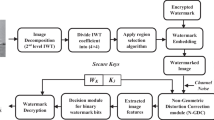Abstract
Data hiding used to embed data, such as copyright information, into various forms of media such as image, audio, or text with a minimum amount of perceivable degradation to the “host” signal. Therefore, in many cases, the cover media contain distortions even after the hidden data have been extracted. Thus, to extend the application of data hiding to some sensitive domains such as military, medical, and fine arts, which require the embedded cover images to be properly covered, reversible data hiding has become another new branch of this field. Our proposed scheme is inspired by Chang et al.’s idea. In this paper, we propose adaptive real-time reversible data hiding for JPEG images using successive zero coefficients in zigzag sequences of discrete cosine transformation blocks. The contribution of our proposed scheme successfully enhances the hiding capacity while the image quality of stego image and reversibility are maintained. The result of experiments conducted indicates that the proposed scheme enhances data hiding capacity, image quality, and improves performance.







Similar content being viewed by others
References
Kim, C.: Data hiding by an improved exploiting modification direction. Multimed. Tools Appl. 69(3), 569–584 (2014)
Kim, C., Shin, D.K., Shin, D.I.: Data hiding in a Halftone image using hamming code (15, 11). Intell. Inf. Database Syst. 6592, 372–381 (2011)
Kim, C., Yang, C.-N.: Steganography based on grayscale images using (5, 3) hamming code. Lect. Notes Comput. Sci. 9023, 588–598 (2015)
Chang, C.C., Hsiao, J.Y., Chan, C.S.: Finding optimal least-significant-bit substitution in image hiding by dynamic programming strategy. Pattern Recognit 36, 1583–1595 (2003)
Chan, C.K., Chen, L.M.: Hiding data in images by simple LSB substitution. Pattern Recognit. 37, 469–474 (2004)
Chang, C.C., Lin, C.Y., Wang, Y.Z.: New image steganographic methods using run-length approach. Inf. Sci. 176(22), 3393–3408 (2006)
Yang, C.H., Wang, S.J.: Weighted bipartite graph for locating optimal LSB substitution for secret embedding. J. Discrete Math. Sci. Cryptogr. 9, 153–164 (2006)
Xia, Z., Wang, X., Sun, X., Liu, Q., Xiong, N.: Steganalysis of LSB matching using differences between nonadjacent pixels. Multimed. Tools Appl. (2014). doi:10.1007/s11042-014-2381-8
Xia, Z., Wang, X., Sun, X., Wang, B.: Steganalysis of least significant bit matching using multi-order differences. Secur. Commun. Netw. 7(8), 1283–1291 (2014)
Gkizeli, M., Pados, D.A., Medley, M.J.: Optimal signature design for spread-spectrum steganography. IEEE Trans. Circuits Syst. Video Technol. 16(2), 391405 (2007)
Chang, C.C., Tsai, P.Y., Lin, M.H.: SVD-based digital image watermarking scheme. Pattern Recognit. Lett. 26(10), 1577–1586 (2005)
Chung, K.L., Yang, W.N., Huang, Y.H., Wu, S.T., Hsu, Y.C.: On SVD-based watermarking algorithm. Appl. Math. Comput. 188(1), 54–57 (2007)
Chang, C.C., Chen, G.M., Lin, M.H.: Information hiding based on search-order coding for VQ indices. Pattern Recognit. Lett. 25(11), 1253–1261 (2004)
Yang, C.H., Lin, Y.C.: Reversible data hiding of a VQ index table based on referred counted. J. Vis. Commun. Image Represent. 20, 399–407 (2009)
Leng, L., Zhang, J., Khan, M.K., Chen, X., Alghathbar, K.: Dynamic weighted discrimination power analysis: a novel approach for face and palmprint recognition in DCT domain. Int. J. Phys. Sci. 5(17), 2543–2554 (2010)
Iwata, M., Miyake, K., Shiozaki, A.: Digital steganography utilizing features of JPEG images. IEICE Trans. Fundam. E87–A(4), 929936 (2004)
Chang, C.C., Lin, C.C., Tseng, C.S., Tai, W.L.: Reversible hiding in DCT-based compressed images. Inf. Sci. 177, 2768–2786 (2007)
Al-Asmari, A.K., Salama, A., Iliyasu, A.M., Al-qodah, M.A.; A DWT ordering scheme for hiding data in images using pixel value difference. In: 2012 Eighth International Conference on Computational Intelligence and Security (CIS), pp. 553–557 (2012)
Fridrich, J., Goljan, M., Du, R.: Invertible authentication, In: Proceedings of the SPIE Security Watermarking Multimedia Contents, San Jose, CA, pp. 197–208 (2001)
Tian, J.: Reversible data embedding using a difference expansion. IEEE Trans. Circuits Syst. Video Technol. 13, 890–896 (2003)
Kamstra, L., Heijmans, H.J.A.M.: Reversible data embedding into images using wavelet techniques and sorting. IEEE Trans. Image Process. 14(12), 2082–2090 (2005)
Thodi, M., Rodrguez, J.J.: Reversible watermarking by prediction-error expansion. In: Proceedings of 6th IEEE Southwest Symposium on Image Analysis and Interpretation, Lake Tahoe, CA, USA, 28–30 March, pp. 21–25 (2004)
Kim, H.J., Sachnev, V., Shi, Y.Q., Nam, J., Choo, H.G.: A novel difference expansion transform for reversible data embedding. IEEE Trans. Inf. Forensics Secur. 3(3), 456–465 (2008)
Shi, Y.Q.: Reversible data hiding. In: IWDW 2004: Third International. Workshop, vol. 3304, pp. 1–12 (2004)
Hong, W., Chen, T.S.: Reversible data embedding for high quality images using interpolation and reference pixel distribution mechanism. J. Vis. Commun. Image Represent. 22, 131–140 (2011)
Tsai, Y.Y., Tsai, D.S., Liu, C.L.: Reversible data hiding scheme based on neighboring pixel differences. Digit. Signal Process. 23, 919–927 (2013)
Huang, L.C., Tseng, L.Y., Hwang, M.S.: A reversible data hiding method by histogram shifting in high quality medical images. J. Syst. Softw. 86, 716–727 (2013)
Leung, H.Y., Cheng, L.M., Liu, F., Fu, Q.K.: Adaptive reversible data hiding based on block median preservation and modification of prediction errors. J. Syst. Softw. 86, 2204–2219 (2013)
Acknowledgments
This research was supported by the Basic Science Research Program through the National Research Foundation of Korea (NRF) by the Ministry of Education, Science and Technology (20120192).
Author information
Authors and Affiliations
Corresponding author
Rights and permissions
About this article
Cite this article
Yang, CN., Kim, C. & Lo, YH. Adaptive real-time reversible data hiding for JPEG images. J Real-Time Image Proc 14, 147–157 (2018). https://doi.org/10.1007/s11554-015-0555-x
Received:
Accepted:
Published:
Issue Date:
DOI: https://doi.org/10.1007/s11554-015-0555-x




